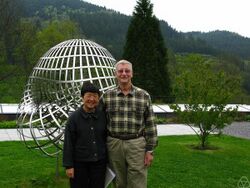Biography:Richard Palais
Richard Palais | |
|---|---|
 Richard Palais (right) and Chuu-Lian Terng (left) at Oberwolfach, 2010 | |
| Born | May 22, 1931 Lynn, Massachusetts, U.S. |
| Nationality | American |
| Alma mater | Harvard University (BA, MA, PhD) |
| Known for | Mostow–Palais theorem Lie–Palais theorem Morse–Palais lemma Palais–Smale compactness condition |
| Spouse(s) | Chuu-Lian Terng |
| Awards | Sloan Research Fellowship (1965) Lester R. Ford Award (2010) |
| Scientific career | |
| Institutions | Brandeis University University of California, Irvine |
| Thesis | A Global Formulation of the Lie Theory of Transformation Groups (1956) |
| Doctoral advisor | Andrew Gleason George Mackey |
| Doctoral students | Edward Bierstone Leslie Lamport Jill P. Mesirov Chuu-lian Terng Karen Uhlenbeck |
Richard Sheldon Palais (born May 22, 1931) is an American mathematician working in differential geometry.
Education and career
Palais studied at Harvard University, where he obtained a BA in 1952, a MA in 1954 and a Ph.D. in 1956. His PhD thesis, entitled A Global Formulation of the Lie Theory of Transformation Groups, was supervised by Andrew M. Gleason and George Mackey.[1]
Palais was a postdoctoral researcher at University of Chicago from 1956 to 1958 and at the Institute for Advanced Study from 1958 to 1960. He moved then to Brandeis University, where he worked as assistant professor in 1960-1962, as associated professor in 1962-1965 and as full professor from 1965 until his retirement in 2003. From 2004 he is adjunct professor at the University of California, Irvine.
Palais was awarded a Sloan Fellowship in 1965.[2] In 1970, he was an invited speaker at the International Congress of Mathematicians in Nice.[3] From 1965 to 1982 he was an editor for the Journal of Differential Geometry and from 1966 to 1969 an editor for the Transactions of the American Mathematical Society. In 1979 he co-found the TeX Users Group and become its first president.[4]
In 1980, Palais was elected a fellow of the American Association for the Advancement of Science[5] and in 2012 a fellow of the American Mathematical Society.[6] In 2006 he was awarded the first prize, together with Luc Bénard, for the NSF/Science Visualization Challenge[7] and in 2010 he received a Lester R. Ford Award.[8]
Research
Palais' research interests include differential geometry, the theory of compact differentiable groups of transformations, the geometry of submanifolds, Morse theory and non-linear global analysis. In particular, he is known for the principle of symmetric criticality, the Mostow–Palais theorem, the Lie–Palais theorem, the Morse–Palais lemma, and the Palais–Smale compactness condition. Since the 1990s he works on the theory of solitons and mathematical visualization.
His doctoral students include Edward Bierstone, Leslie Lamport, Jill P. Mesirov, Chuu-lian Terng, and Karen Uhlenbeck.[1]
Selected publications
Books
As editor:
- Seminar on the Atiyah-Singer Index Theorem, Annals of Mathematical Studies, no. 4, Princeton Univ. Press, 1964
As author:
- A Global Formulation of the Lie Theory of Transformation Groups, Memoirs AMS 1957
- The classification of G-Spaces, Memoirs AMS 1960
- Foundations of Global Nonlinear Analysis, Benjamin 1968
- The geometrization of physics, Tsinghua University Press 1981
- Real algebraic differential topology, Publish or Perish 1981
- with Chuu-Lian Terng: Critical point theory and submanifold geometry, Lecture Notes in Mathematics, vol.1353, Springer 1988
- with Robert A. Palais: Differential Equations, Mechanic, and Computation, AMS 2009
Articles
- Richard Palais and Stephen Smale, A generalized Morse theory, Research Announcement, Bulletin of the American Mathematical Society 70 (1964), 165-172
- R. Palais, Morse Theory on Hilbert Manifolds, Topology 2 (1963), 299–340.
- R. Palais, Linear and Nonlinear Waves and Solitons, in The Princeton Companion to Mathematics, T. Gower Ed., Princeton Univ. Press 2008, 234-239 ([1])
- R. Palais, The Symmetries of Solitons, Bulletin. Amer. Math. Soc., New Series 34, No. 4, 339-403 (1997) [ISSN 0273-0979], ([2])
- R. Palais, The Visualization of Mathematics: Towards a Mathematical Exploratorium, Notices Amer. Math. Soc., 46, No. 6 (June–July 1999, ([3])
- R. Palais, A Simple Proof of the Banach Contraction Principle, The Journal for Fixed Point Theory and its Applications, 2 (2007) 221–223, ([4])
A nearly complete list of all papers authored or co-authored by Richard Palais is available for downloading as PDF files at http://vmm.math.uci.edu/PalaisPapers
References
- ↑ 1.0 1.1 Richard Sheldon Palais at the Mathematics Genealogy Project
- ↑ "Fellows Database". https://sloan.org/fellows-database.
- ↑ Berger, Marcel; Dieudonné, Jean; Leray, Jean et al., eds (1970). Actes du Congrès international des mathématiciens, 1970. 2. pp. 243-249. https://www.mathunion.org/fileadmin/ICM/Proceedings/ICM1970.2/ICM1970.2.ocr.pdf.
- ↑ Walden, Dave. "Richard Palais - Interview". https://tug.org/interviews/palais.html.
- ↑ "Elected Fellows" (in en). https://www.aaas.org/fellows/listing.
- ↑ List of Fellows of the American Mathematical Society, retrieved 2013-05-05.
- ↑ Nesbit, Jeff; Bradford, Monica (2006-09-22). "2006 Visualization Challenge" (in en). Science 313 (5794): 1729–1729. doi:10.1126/science.313.5794.1729. ISSN 0036-8075. https://www.science.org/doi/10.1126/science.313.5794.1729.
- ↑ Palais, Bob; Palais, Richard; Rodi, Stephen (2009). "A Disorienting Look at Euler's Theorem on the Axis of a Rotation". Amer. Math. Monthly 116 (10): 892–909. doi:10.4169/000298909x477014. http://www.maa.org/programs/maa-awards/writing-awards/a-disorienting-look-at-eulers-theorem-on-the-axis-of-a-rotation.
External links
- Richard Palais at the Mathematics Genealogy Project
- Home page
- Curriculum Vitae
- Homepage of 3D-XplorMath, Mathematical Visualization software developed by R. Palais
- Interview with the TeX Users Group
 |

